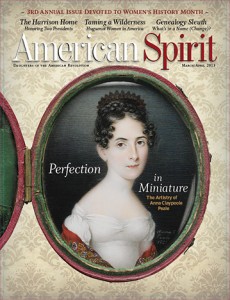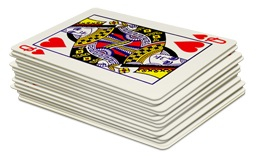


 American Spirit, the national magazine of the Daughters of the American Revolution (DAR)*, has a strong track record of bringing to light stories about brave and groundbreaking women of history whose lives aren’t very familiar to most people.
American Spirit, the national magazine of the Daughters of the American Revolution (DAR)*, has a strong track record of bringing to light stories about brave and groundbreaking women of history whose lives aren’t very familiar to most people.
Nowhere is that focus more apparent than in the magazine’s third annual issue devoted to Women’s History Month.
The cover feature looks at the lives of Anna Claypoole Peale and Sarah Miriam Peale. The sisters not only found distinction as highly skilled 19th-century portrait artists, but they also were remarkable in another respect: They were able to support themselves financially in an age when women were supposed to be homemakers, not artisans.
Though Irish immigrant Margaret Haughery’s early life was marred by tragedy and she had no formal schooling, she persevered to become a successful entrepreneur in 19th-century New Orleans. This issue includes a feature examining how she dedicated her life to helping orphans in that disease-plagued city, inspiring many of her fellow citizens to call her the Angel of the Delta.
A few days ago, Rex Hammock was featured on the blog of the Boston-based Venture Fund, OpenView Partners about his recent posts claiming that “Content isn’t King.” Don’t worry. Rex isn’t turning his back on a career in content marketing. His complete claim was, “Content isn’t king. Brilliant, creative content is king.”
The OpenView Labs blog is a great example of a company that utilizes an excellent content marketing strategy. Open View Patners is a Boston-based venture fund that, in addition to investing in tech startups, provides the type of knoweledge and resources (content) the founders of those companies need to succeed.
 (This essay was sent today as part of the Hammock Idea Email series called “Beyond Selling.” You can receive each essay via email if you subscribe here.)
(This essay was sent today as part of the Hammock Idea Email series called “Beyond Selling.” You can receive each essay via email if you subscribe here.)
A long-time customer makes an offhand remark that shows he or she isn’t paying attention to important information you’ve been sending for months. It’s perplexing. Your data shows the customer has opened your email. Maybe the customer even purchased the product you’ve been promoting. But still, they don’t seem to be connecting the dots between your message and their perception of its significance.
What’s up with that? Why is your message being ignored?
Last week, NPR ran a story about ongoing research into how we all use selective attention to either ignore or absorb information. The research began almost 15 years ago with a video that challenges viewers to count the number of basketball passes made by students wearing white shirts (Watch it now before reading on — it’s a great way to test your concentration.)
If you’re familiar with the video, you know that 50% of those tested were so focused on counting the passes, they didn’t notice — spoiler alert! — when someone in a gorilla costume walked through the middle of the students and stopped to beat his chest. The lesson: People look for what they’ve been trained or told to look for — so much so, they can be blind to something as obvious as a guy in a gorilla suit.
[Post by Rex Hammock]

According to one theory, the word ‘deck,’ when used after the word PowerPoint, is inspired by a deck of cards and serves a metaphor for how one can arrange and shuffle the slides created on software like PowerPoint and Keynote. However, anyone over the age of 40 or who has watched Mad Men knows that old-school presentation slides weren’t stacked in decks, but were placed in the circular part of a time machine called the Kodak Carousel.
On Wednesday, the White House posted an “enhanced version” of the President’s State of the Union address on Slideshare. (If you’re reading this on the Hammock Blog, it should be embedded below.) The enhanced version is a 107-slide, yes, 107-slide PowerPoint deck. As PowerPoints go, the quality of the graphics and design are superior to 99% of the PowerPoint decks you and I have ever endured. In other words, no deficits were reduced in the production of this 107-slide PowerPoint deck. (Have I mentioned there are 107 slides in the deck?)
But is a PowerPoint deck, even a great one, the best medium to use for after-the-presentation communications?
Read on, and you’ll understand why I say, “No.”
At Hammock, one of the things we do is work with large companies to develop sales presentation systems that are intended to help lead a customer to make the decision to buy a specific product or service. The presentations in these systems don’t merely run through concepts, and, most of all, they don’t just serve as an outline to remind the sales person the next thing they want to say. They sell something.
When we first start working with a client, the most shocking thing (to the sales person, at least) seems to be when we tell them this: Never give out your deck following a presentation!
Why is it shocking? Because that seems to be a universal practice. The prospect sees something they want to remember and asks politely and with interest, “Hey, can you give me a copy of this presentation?” The sales person, not having anything else to give them, says, “Sure.”
Seems harmless enough, so why would we suggest banning the practice?

Everyone knows the funny-yet-true Murphy’s Law: “Anything that can go wrong, will go wrong.”
But have you ever heard of “Wiio’s Laws”? They are from Finnish author and communications professor Osmo Wiio.
In the late 1970s, Wiio was elected to his country’s parliament where he served for four years. Not surprisingly, it was during this stint as a politician that he formulated his theories on why “communication usually fails except by accident.”
[Post by Rex Hammock]
Because Hammock has a long history of publishing print magazines while, simultaneously, serving as creators of digital media delivered to audiences via screens (starting back in the days of CompuServe and laserdiscs), I’m often asked about the future of print magazines – as in: Will print magazines still be around in the future?

Time is ticking away.
These questions typically spike whenever there is news involving closures or layoffs at once-powerful magazines like Time or Newsweek. or when a famous person like a Facebook co-founder sparks a lot of media coverage for buying a magazine like The New Republic.
Here’s my quick answer to the question, “Will print magazines be around in the future?”:
“Yes, but…”
For a much longer version of this answer – a version with predictions covering all types of print magazines – read on…
[Cross-posted on Rex Hammock’s RexBlog.com]
A few seconds after I saw the Super Bowl power outage “Oreo tweet” last night, I was so awed, I responded with the tweet below (Note: the time-stamp is GMT.) Scroll down, and you’ll find my Monday morning thoughts about what made it such a breakthrough use of social media.
What Apple 1984 is to TV ads, this is to use of Twitter @oreo: Power out? No problem. twitter.com/Oreo/status/29…”
— Rex Hammock (@R) February 4, 2013
Monday morning, 5:30 a.m.:
I’m not a fan of long explanations of the self-evident, but I know there will be much misinterpretation of why the Oreo tweet was brilliant, so I wanted to weigh in before the media sites that write headlines for Google (Huffington Post) start their SEO avalanche of headlines like “10 lessons you can learn from the Oreo tweet.”
Here are my two takeaways of why the Oreo tweet is the most outstanding use of use of Twitter as a unique marketing medium and distribution channel. (Note: There are countless ways to use Twitter, and far more important ways than mere marketing.)